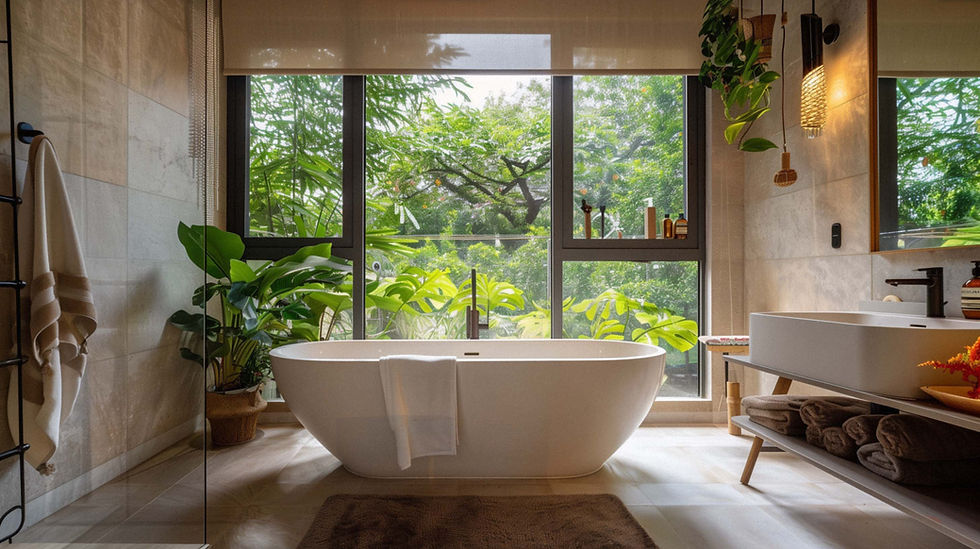European vs American Interior Design: Key Differences and Inspirations
- Marieke Rijksen

- Apr 9
- 5 min read
Interior design is more than just arranging furniture and picking colour schemes - it’s a reflection of culture, history, and the way we live. The way homes are designed and decorated says a lot about a country’s traditions, lifestyle, and even architecture. While every home is unique, certain trends tend to define different parts of the world.
As an interior design tutor working online for The Interior Design Institute, I have the privilege of working with students from across the globe, many of them in the US and Canada.
Based in the Netherlands, I’ve noticed how interior design choices differ between Europe and North America - not just in terms of aesthetics, but also in how spaces are used and what people prioritise in their homes.
Of course, design is deeply personal, and every home tells its own story. But broadly speaking, there are clear trends that set European and American interiors apart. Both have their strengths, and both offer inspiration for anyone looking to refine their own style. Let’s explore these differences and see how we can take the best of both worlds.

Space and Layout The Impact of Architecture
One of the biggest differences between European and North American homes is how space is used.
Europe: Many European homes are designed with efficiency in mind. In cities especially, space is often limited, so layouts prioritise functionality. Multifunctional furniture, built-in storage, and smaller-scale furnishings help maximise every square metre. Older homes, with their charming yet compact rooms, encourage creative space-saving solutions.

North America: With more available land, homes tend to be larger, featuring open-plan layouts that create a bright and airy feel. Expansive kitchens, spacious living areas, and generous storage options - like walk-in closets and basements - are common. These layouts foster a sense of openness, making them ideal for entertaining and family gatherings.

Neither approach is better or worse - they simply reflect the realities of available space and lifestyle preferences. While European interiors demonstrate how to make the most of smaller spaces, American homes embrace openness and flow in a way that feels welcoming and comfortable.
Design Philosophy Practicality vs Personal Expression
Europe: European design leans towards practicality and timelessness. Many homes blend old and new, with an emphasis on craftsmanship and longevity. Interiors often evolve over time, creating a collected, layered look where vintage and modern pieces coexist beautifully.

North America: North American interiors celebrate comfort, personal expression, and the freedom to experiment. There’s a greater openness to following trends, customising spaces to reflect personality, and refreshing interiors regularly. Whether it’s a statement wall, a bold colour choice, or a completely renovated kitchen, homeowners here embrace change and creativity.

While European design teaches us the value of enduring style, North American interiors highlight the joy of customisation and adaptability. Both approaches offer something valuable, depending on what speaks to you most.
Material Choices and Sustainability
Sustainability is becoming more of a global focus, but historically, the approach to materials has differed.
Europe: There’s a strong tradition of using natural materials like wood, stone, and clay. Vintage and second-hand furniture is not just accepted but often preferred, both for its durability and character. Many people invest in high-quality pieces that last for decades.

North America: While mass-market furniture is widely available, there’s also a growing movement towards sustainable and locally sourced materials. Reclaimed wood, eco-friendly paints, and energy-efficient appliances are becoming more common. The flexibility of the market means homeowners can choose between convenience and sustainability depending on their priorities.

European interiors offer lessons in long-term thinking, while North American design reflects the exciting innovation happening in sustainable home solutions. Together, they present a well-rounded approach to conscious living.
Colour Palettes and Styling Trends
Europe: Subtle, natural tones are the foundation of many European interiors. Inspired by Scandinavian, French, and Italian influences, muted palettes of greys, beiges, and earth tones create a calm, sophisticated atmosphere. The focus is often on timeless elegance rather than fleeting trends.

North America: There’s a stronger embrace of colour and contrast. Whether it’s deep blues, rich greens, or bold wallpaper patterns, American interiors often feel more expressive. Themed decorating is also popular - from modern farmhouse to industrial loft, spaces often reflect a specific aesthetic. Social media, particularly Pinterest and Instagram, plays a huge role in shaping these evolving trends.

While European palettes create a sense of understated luxury, North American design celebrates personality and individuality. There’s something to be learned from both - whether it’s curating a timeless space or having the confidence to embrace bold design choices.
Customisation vs Convenience
Europe: There’s a strong appreciation for bespoke, artisan-made furniture and handcrafted pieces. Many homeowners mix contemporary items with family heirlooms, vintage finds, and unique designs that create a space filled with character.

North America: While customisation exists, the market is driven by convenience. Brands like Pottery Barn, West Elm, and Crate & Barrel offer stylish, ready-made solutions that allow homeowners to quickly achieve a cohesive look. This accessibility makes it easier to refresh a space when tastes evolve.

While European interiors often feel more curated over time, North American interiors make design accessible and practical. The key is finding a balance that works for your lifestyle.
The Influence of History and Heritage
Europe: Historical influences are everywhere. Many homes integrate original architectural details - ornate mouldings, exposed beams, or stone floors - into modern living. Even in contemporary spaces, there’s often a deep respect for heritage, with furniture and decor choices reflecting the past.

North America: While history plays a role, the approach is more flexible. Many homeowners take inspiration from historical European styles but adapt them to suit modern life. From Tuscan-inspired kitchens to Parisian-chic apartments, there’s a beautiful fusion of old-world charm and fresh innovation.

While European homes seamlessly blend history with the present, North American interiors showcase how traditional styles can be reinterpreted in exciting, modern ways.
Key Takeaways for Global Interior Designers
So, what can we learn from these different approaches?
From Europe: Focus on quality and longevity. Invest in well-crafted, timeless pieces, embrace sustainability, and let your home evolve over time.
From North America: Be bold and adaptable. Take risks with colour, layout, and design updates, and make your home a true reflection of your personality.
As someone who teaches students from all over the world, I’ve seen how these influences merge. More Americans are embracing the European focus on sustainability and quality, while European homes are incorporating North American-style open layouts and customisation.
The best designs take inspiration from both, creating homes that are stylish, functional, and deeply personal.

Regional Differences Within Europe and the US
While this blog broadly contrasts European and American interior design, it’s important to recognise that both regions are incredibly diverse. In Europe, a Scandinavian home with its clean lines and minimalism looks vastly different from a French countryside cottage filled with antique charm. Italian interiors often embrace bold luxury, while Dutch homes prioritise practicality and smart space-saving solutions.
Southern Europe tends to favour warm, sun-soaked tones, whereas Northern European countries lean towards cooler, muted palettes.

Similarly, the US is far from a one-size-fits-all approach to design. A sleek, modern apartment in New York City has little in common with a sprawling Texan ranch, just as a charming New England home with its traditional woodwork contrasts with a relaxed, beachy California aesthetic.

Regional influences, climate, and historical context shape interiors across the US, making the design landscape as varied and distinctive as it is in Europe.
Conclusion
European and American interior design reflect different histories, cultures, and ways of living - but both offer inspiration in their own way. Whether you love the curated charm of European interiors or the comfort and creativity of American homes, there’s no right or wrong way to design your space.
At the end of the day, great design is about making a home that feels truly yours. And if you can take a little inspiration from both sides of the Atlantic, even better!





